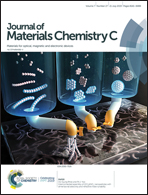A SERS-based immunoassay for the detection of α-fetoprotein using AuNS@Ag@SiO2 core–shell nanostars†
Abstract
A surface-enhanced Raman scattering (SERS)-based sandwich type immunoassay was developed for the detection of α-fetoprotein (AFP) with high sensitivity, reproducibility and selectivity. In the immunoassay, an antibody immobilized nitrocellulose (NC) membrane was employed to capture AFP and antibody conjugated silica coated gold/silver core–shell nanostars (AuNS@Ag@SiO2) were used as SERS probes. AuNS@Ag was synthesized by the direct deposition of Ag on the AuNS. The Ag shell grew outward from the center towards the tips and adopted a polyhedral shape. The AuNS@Ag nanoparticles were shown to have higher SERS activity than gold nanostars (AuNSs), and their LSPR wavelengths could be finely tuned across a wide spectrum ranging from visible to near-infrared by simply adjusting the Ag shell thickness. The silica coating improved colloidal stability of the nanostructure and provided functionality for antibody conjugation. By using 4-mercaptobenzoic acid (4-MBA) as a Raman reporter molecule, the proposed SERS sensor is able to detect AFP with a low limit of detection (LOD) of 0.72 pg mL−1 and a wide and clinically relevant linear detection range from 3 pg mL−1 to 3 μg mL−1. Hence, this SERS-based immunoassay provides a strategy for the detection of trace AFP and has potential to assist in the monitoring of prognosis for hepatocellular carcinoma (HCC) patients.



 Please wait while we load your content...
Please wait while we load your content...